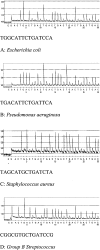Use of pyrosequencing of 16S rRNA fragments to differentiate between bacteria responsible for neonatal sepsis
- PMID: 15681481
- PMCID: PMC1867504
- DOI: 10.1016/s1525-1578(10)60015-3
Use of pyrosequencing of 16S rRNA fragments to differentiate between bacteria responsible for neonatal sepsis
Abstract
Infants admitted to neonatal intensive care units for suspicion of bacterial sepsis receive at least two broad-spectrum antibiotics for a minimum of 48 to 72 hours to cover both gram-positive and gram-negative organisms while awaiting blood culture results. On average, bacterial growth becomes detectable within 12 to 24 hours, with an additional 24 to 48 hours required for identification. We have previously described using a 16S rRNA PCR assay for screening neonatal blood for bacterial DNA. Combining PCR with DNA sequencing could prove a faster means of detecting bacteria than culture-based identification. If successful, antibiotic therapy could be appropriately tailored sooner, thus sparing infants the administration of unnecessary antibiotics. Our goal was to assess the potential of pyrosequencing to differentiate between bacteria commonly associated with neonatal sepsis. To begin, full-length sequencing of the 380-bp 16S rRNA amplicons from representative bacteria was conducted (ABI 3100) and several databases queried. These included Staphylococcus sp., Streptococcus sp., Listeria sp., and numerous gram-negative rods. The sequences from clinical isolates were identical to those present in the published databases for the same bacteria. As a result, an informative 15 bases within the 380-bp amplicon was targeted for pyrosequencing following enrichment culture and PCR amplification. A total of 643 bacterial isolates commonly associated with neonatal sepsis, and 15 PCR-positive, culture-positive neonatal whole blood samples were analyzed by pyrosequencing. Results of DNA sequencing and culture identification were compared. In summary, we were successful at using PCR and pyrosequencing together to accurately differentiate between highly diverse bacterial groups.
Figures
References
-
- Cerase PA. Neonatal sepsis. J Perinatal Neonatal Nursing. 1989;3:48–57. - PubMed
-
- Gerdes JS. Clinicopathologic approach to the diagnosis of neonatal sepsis. Clin Perinatol. 1991;18:361–381. - PubMed
-
- Klein JO, Marcy SM. Bacterial sepsis and meningitis. Infectious Diseases of the Fetus and Newborn. Remington J, Klein J, editors. Philadelphia: W.B. Saunders; 1990:p 601.
-
- Witek-Janusek L, Cusack C. Neonatal sepsis: confronting the challenge. Crit Care Nurs Clin North Am. 1994;6:405–419. - PubMed
-
- Freedman RM, Ingram DL, Gross I, Ehrenkranz RA, Warshaw JB, Baltimore RS. A half century of neonatal sepsis at Yale: 1928 to 1978. Am J Dis Child. 1981;135:140–144. - PubMed
Publication types
MeSH terms
Substances
Grants and funding
LinkOut - more resources
Full Text Sources
Other Literature Sources
Research Materials


